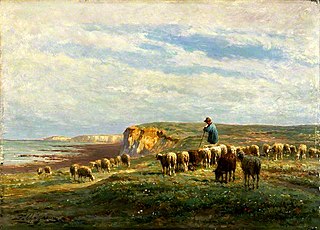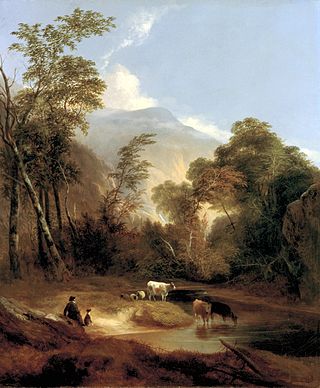Related Research Articles
In poetry, enjambment is incomplete syntax at the end of a line; the meaning 'runs over' or 'steps over' from one poetic line to the next, without punctuation. Lines without enjambment are end-stopped. The origin of the word is credited to the French word enjamber, which means 'to straddle or encroach'.

A villanelle, also known as villanesque, is a nineteen-line poetic form consisting of five tercets followed by a quatrain. There are two refrains and two repeating rhymes, with the first and third lines of the first tercet repeated alternately at the end of each subsequent stanza until the last stanza, which includes both repeated lines. The villanelle is an example of a fixed verse form. The word derives from Latin, then Italian, and is related to the initial subject of the form being the pastoral.
Literal and figurative language is a distinction that exists in all natural languages; it is studied within certain areas of language analysis, in particular stylistics, rhetoric, and semantics.
Poetry analysis is the process of investigating the form of a poem, content, structural semiotics, and history in an informed way, with the aim of heightening one's own and others' understanding and appreciation of the work.

The pastoral genre of literature, art, or music depicts an idealised form of the shepherd's lifestyle – herding livestock around open areas of land according to the seasons and the changing availability of water and pasture. The target audience is typically an urban one. A pastoral is a work of this genre. A piece of music in the genre is usually referred to as a pastorale.

Allan Ramsay was a Scottish poet, playwright, publisher, librarian and impresario of early Enlightenment Edinburgh. Ramsay's influence extended to England, foreshadowing the reaction that followed the publication of Percy's Reliques. He was on close terms with the leading men of letters in Scotland and England. He corresponded with William Hamilton of Bangour, William Somervile, John Gay and Alexander Pope.

Robert Tannahill was a Scottish poet of labouring class origin. Known as the 'Weaver Poet', he wrote poetry in English and lyrics in Scots in the wake of Robert Burns.

The poem In Memoriam A.H.H. (1850) by Alfred, Lord Tennyson, is an elegy for his Cambridge friend Arthur Henry Hallam, who died of cerebral haemorrhage at the age of twenty-two years, in Vienna in 1833. As a sustained exercise in tetrametric lyrical verse, Tennyson's poetical reflections extend beyond the meaning of the death of Hallam, thus, In Memoriam also explores the random cruelty of Nature seen from the conflicting perspectives of materialist science and declining Christian faith in the Victorian era (1837–1901), the poem thus is an elegy, a requiem, and a dirge for a friend, a time, and a place.
"Address to the Devil" is a poem by Scottish poet Robert Burns. It was written in Mossgiel in 1785 and published in the Kilmarnock volume in 1786. The poem was written as a humorous portrayal of the Devil and the pulpit oratory of the Presbyterian Church.

"Tam o' Shanter" is a narrative poem written by the Scottish poet Robert Burns in 1790, while living in Dumfries. First published in 1791, at 228 lines it is one of Burns' longer poems, and employs a mixture of Scots and English.

Timor mortis conturbat me is a Latin phrase commonly found in late medieval Scottish and English poetry, translating to "fear of death disturbs me". The phrase comes from a responsory of the Catholic Office of the Dead, in the third Nocturn of Matins:
The Scots song "Ae fond kiss and then we sever" by the Scottish poet Robert Burns is more commonly known as "Ae fond kiss". It is Burns's most recorded love song.

Sonnet 22 is one of 154 sonnets written by the English playwright and poet William Shakespeare, and is a part of the Fair Youth sequence.

Sonnet 78 is one of 154 sonnets published by the English playwright and poet William Shakespeare in 1609. It is one of the Fair Youth sequence, and the first of the mini-sequence known as the Rival Poet sonnets, thought to be composed some time from 1598 to 1600.
"The Flea" is an erotic metaphysical poem by John Donne (1572–1631). The exact date of its composition is unknown, but it is probable that Donne wrote this poem in the 1590s when he was a young law student at Lincoln's Inn, before he became a respected religious figure as Dean of St Paul's Cathedral. The poem uses the conceit of a flea, which has sucked blood from the male speaker and his female lover, to serve as an extended metaphor for the relationship between them. The speaker tries to convince a lady to sleep with him, arguing that if their blood mingling in the flea is innocent, then sexual mingling would also be innocent. His argument hinges on the belief that bodily fluids mix during sexual intercourse.

Poetry of Scotland includes all forms of verse written in Brythonic, Latin, Scottish Gaelic, Scots, French, English and Esperanto and any language in which poetry has been written within the boundaries of modern Scotland, or by Scottish people.
Poetic devices are a form of literary device used in poetry. Poems are created out of poetic devices via a composite of: structural, grammatical, rhythmic, metrical, verbal, and visual elements. They are essential tools that a poet uses to create rhythm, enhance a poem's meaning, or intensify a mood or feeling.

Poems is a collection of poetry and songs by David Sillar, a close friend of the poet Robert Burns who had been encouraged to go into print by the success of Poems, Chiefly in the Scottish Dialect. Poems was printed by John Wilson of Kilmarnock in 1789. Sillar's interest in poetry predated his friendship with Burns, but was one of several reasons for it.

Robert Burns's Commonplace Book 1783–1785 is the first of three commonplace books that were produced by the poet. The contents cover drafts of songs and poems, observations, ideas, epitaphs, etc.
"Man Was Made to Mourn: A Dirge" is a dirge of eleven stanzas by the Scots poet Robert Burns, first published in 1784 and included in the first edition of Poems, Chiefly in the Scottish Dialect in 1786. The poem is one of Burns's many early works that criticize class inequalities. It is known for its line protesting "Man's inhumanity to man", which has been widely quoted since its publication.
References
- ↑ Evans, Bergen; Cornelia Evans (1957). A Dictionary of Contemporary American Usage. Random House. p. 145.
- 1 2 "'Dressed to the nines' comes from old Scottish phrase". Deseret News. April 13, 1997. Archived from the original on October 30, 2013. Retrieved 13 November 2011.
- 1 2 "'Dressed to the nines' - the meaning and origin of this phrase". Phrasefinder. Retrieved 12 April 2018.
- ↑ "Robert Burns Country: Poem on Pastoral Poetry".
- ↑ "Poems and Songs of Robert Burns, by Robert Burns".